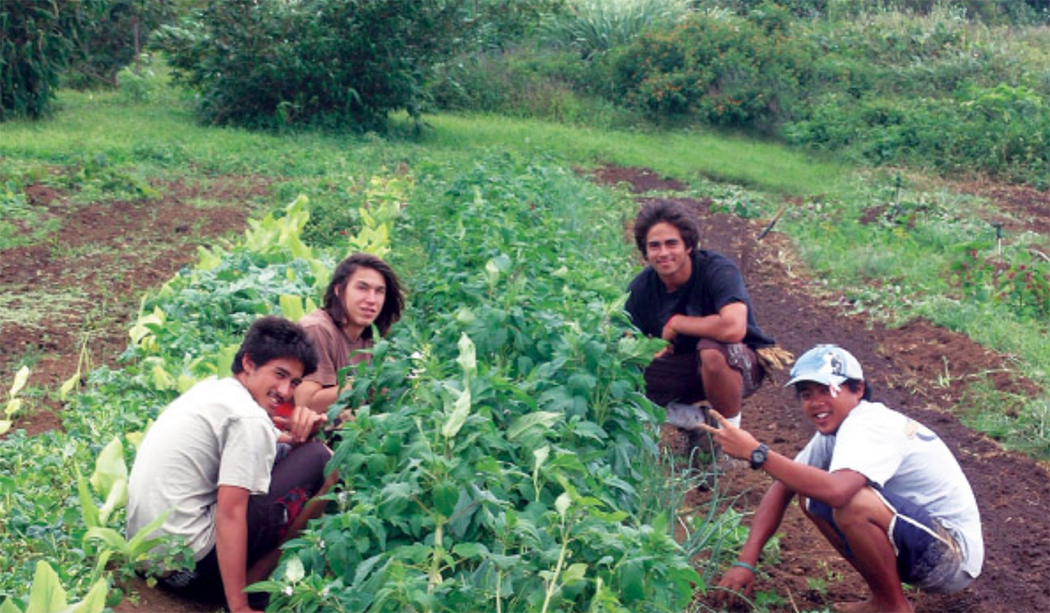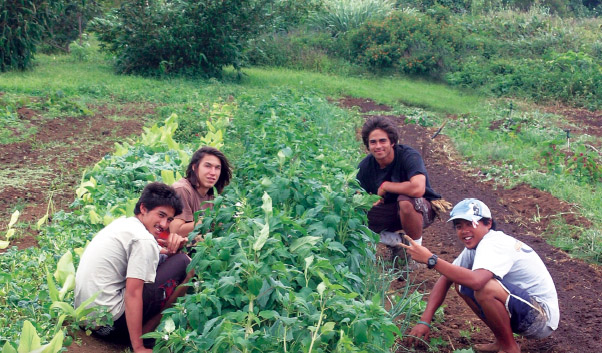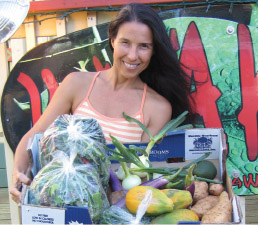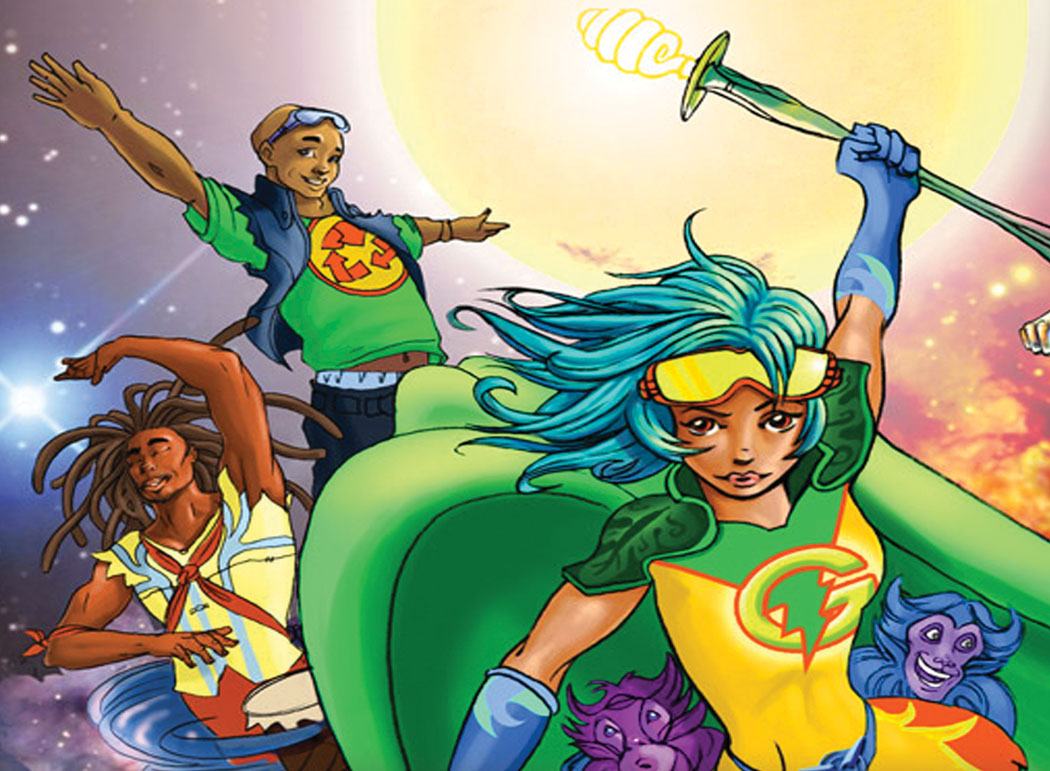
The “Cool Factor” Bonds Youth and Farming

By Andrea Dean
Dashiell Hammet was a famous detective novelist. Dashiell Kuhr, of North Kohala, is the energetic, articulate, handsome (dare I say dashing) driving force behind the Hawai‘i Youth Agriculture Program and the operations of Uluwehi Farm and Nursery, a CSA (Community Supported Agriculture) farm in North Kohala.
The owners, Tom Baldwin and Shannon Casey, were looking for someone to help manage their two North Kohala permaculture farms. Tom was introduced to Dash through a mutual friend and thus was the beginning of a fruitful (and vegetable!) relationship. Dash, his wife Erika Shickle, and their baby son Cyrus came to North Kohala in early 2008 and the collaboration has grown into a unique CSA/educational program.
Dash the farmer becomes Dr. Dash the DJ by night when he spins vinyl (yes vinyl!) and is a spoken-word artist. The guy is just plain cool. And what does cool have to do with agriculture, you might ask? He is not just growing carrots, beets, kale, collards, chard, salad green, yakon, pumpkins, winter squash, taro, sweet potatoes, greens and lettuce on the farm—he is growing young farmers. Given that farming as a profession has lost its luster over the years, cool is imperative in making farming seem like an attractive career option for Hawaii’s youth.

Underneath all that cool, there are solid roots. Kuhr first came to farming with youth through an interest in health and nutrition education. He recognized how the production of toxic food was compounding environmental problems and contributing to a precipitous decline in our nation’s health. Living in San Diego, he ran school garden programs for the World Beat Cultural Center, conducted farm field trips at La Milpa Organica Farm, and did classroom education at Point Loma High School. He saw first-hand how getting young hands in the dirt helped transform eating habits and effect lifestyle changes.
The original CSA farming model was comprised of a group of people who bought a farm, hired a manager, and then shared in the bounty—or the loss. The idea was to create community, spread the risk out over many people, and have a source of fresh, local food. Most CSA’s these days operate on a subscription model, where people purchase membership subscriptions in the CSA (which the farmer either owns or runs) and they get a weekly box of produce from the farm. The advantage to the farmer is that they know they will be growing for a fixed number of people over a fixed time period, which takes the guess work out of knowing how much to plant and who will buy it.
The Uluwehi Farm CSA is in its first year of operation at Niuli‘i (towards Pololu Valley) and has almost 20 local customers who pay weekly—$24 for a large box or $12 for a small box. Customers pick up their boxes in Hawi on the deck between the Kohala Coffee Mill and Kava Kafé after 4 p.m. on Wednesday. Inevitably you run into other CSA members picking up their boxes, and you can then end your day with either a coffee or a kava. A great example of agriculture creating community.
Dash, Tom and Shannon started talking about how to incorporate more youth and education into the farm. Tom and Shannon had already been running permaculture education classes and an internship program. The economic reality of running a family farm, however, is that there is not much gravy left for funding educational programs. “Farming is a third-world profession at this point; that is who we are competing against,” Tom says. “It’s easy to get things going, but whether or not it makes a profit is another thing. The costs are high to farm. Dash is an employee of the farm, and all the profit pays his wages and expenses.”
Enter Nancy Redfeather, who had just been hired by the Kohala Center as the Program Director of the Hawai‘i Island School Garden Network. Nancy saw that Dash’s vision of fostering young farmers on a working commercial farm was a good fit for the program and the Kohala Center helped facilitate funding for the Hawai‘i Youth Agriculture Program.
“The Kohala Center seeks to impact food production on Hawai‘i Island across the full length of the local food chain from production to consumption,” says Kohala Center Deputy Director Betsy Cole, “A key element in the transition towards locally grown and consumed food is the availability and training of farmers. The Kohala Center found that, at Uluwehi Farm, there was a talented young farmer with an interest and capacity to teach, and owners who wanted their land used for both agricultural production and for the development of family farmers. So there was a great private-public partnership fit.”
The Hawai‘i Youth Agriculture Program, a non-profit educational program nestled within the commercial Uluwehi Farms, has supported the farm business as well. The youth farmers get paid a grant-funded stipend to learn and work on the farm.
“The program has allowed us to have a degree of labor to successfully farm and have education. This makes a small family farm workable in a difficult economy for farmers,” says Baldwin,” We needed labor and have an interest in education, the grant money has fostered the program along in its infancy.” Uluwehi Farms and the Hawai‘i Youth Agriculture Program is selling produce to restaurants, at farmers’ markets in Waimea and Keauhou, as well as through their CSA program.
Dash is serious about growing food and is always energetically working the farm, teaching youth by modeling the process—saving seed, propagating, planting, harvesting and marketing. He is authentically into it, and that is what appeals to the youth who work with him.

My son Kanoe (who, judging by what my yard and garden look like, had no interest in agriculture) has worked for two summers at the Hawai‘i Youth Agriculture Program. When I asked him what he likes about working at the farm he says, “It sparks an actual interest in farming for the rest of your life. It’s nice to work with someone you actually respect.” When pressed for more information (as one has to do with teenage boys) he said that his respect for Dash was “Because of his enthusiasm for what he does and his life as a DJ outside the farm.” By holding regular music events at the local kava bar, the Kava Kafè, Dash and the students have created culture around the agriculture.
At Uluwehi Farms, they sometimes have cooking demonstrations in their outdoor classroom. During one of these meals, some teenagers had beets for the first time. “I would never have thought this would taste so good without meat,” one student remarked.
In addition to growing future farmers, the Uluwehi Farms and the Hawai‘i Youth Agriculture Program is growing a lot of food. The farm is one of only a handful of commercial production farms in North Kohala and is a key player in the drive for greater local food self-reliance in the area.
The North Kohala Food Forum (this author was an organizer) just convened 200 residents to talk about how to reach a community goal of locally producing 50 percent of the food we consume. According to survey data collected by the Food Forum, North Kohala food stores sell only about 1 percent locally-grown produce, while restaurants and other commercial buyers use about 8 percent.
“We are not just growing farmers,” says Baldwin, “We are creating entrepreneurs.” What’s next? Take a deep breath… Dash sees the CSA membership growing, creating more local jobs, a food co-op, a local food café, a youth-run farm and food store, an island-wide educational campaign, engaging in community-based action, and leasing land for multiple small farms with housing. Dashing, indeed.
“We are still in the early stages, things are unfolding” says Dash, “We are at the forefront of a revolution.” ❖

